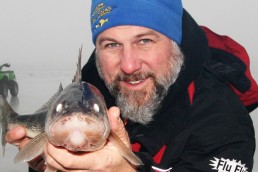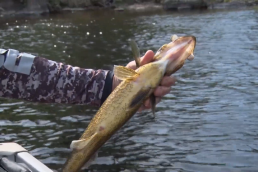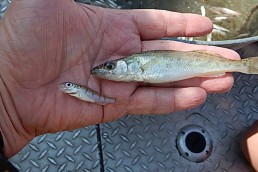The Walleye Perch Pike Connection
SHARE THIS POST
When I catch a 4-inch perch, I get excited! Not because a 4-inch perch is a new perch record for me, but because a 4-inch perch represents bait! In fact, in the lakes that I ice fish, it is legal to use a perch as bait so long as I don’t transport them alive to a different body of water. Believe me, the only place I’m going to transfer that perch is to my deadstick rod, tip-up or bait bucket! A 10-inch perch is a different story; I call that one dinner. But it also could mean that a larger predator is around like, say, a monster walleye or girthy pike. This is the walleye, perch, pike connection.
Perch are schoolers; if you find one, chances are you will find several. They also tend to school by size, because there is safety in numbers, I guess. Perch like sandy areas, gravelly areas and rocky areas. Points, reefs and shallow, but not too weedy areas are where you will find them. The smallest perch tend to be shallower, maybe because there are more hiding places for them, or because it’s a better area to find food for their tiny mouths.
Perch are nosy. They like flashy things. Flashy jigs and spoons are best. Even though perch have small mouths, they have a big appetite. My top lures for perch are Custom Jigs & Spins (CJS) 1/16-ounce Slender Spoons, size 14 Diamond Jigs and 1/16-ounce Slip Droppers. I’ll add spikes for bait. You can “spike up” the trebles on the Slender Spoon, or even better, remove the treble and replace it with a size 14 Pro Finesse Drop Chain. The spoon attracts them in, and they will hit the dropper chain every time.
A size 14 gold Diamond Jig is a great perch bait. I’ll thread four or five spikes up the hook and drop it down. The reason to pile on the spikes is so after you catch one, you don’t have to re-bait; just drop it back down and grab another perch. The 1/16th ounce Slip Dropper is another option; it gets rigged so you can slide the treble closer or farther away from the spoon (an adjustable dropper). Also, if you’re catching perch and the action stops, it’s time for the big spoon to attract them back to the hole; we’re talking about a 4- to 8-inch, flashy pike spoon, folks.
Tip-ups are a great way to catch walleyes and pike. I like setting my tip-ups shallow, away from the crowd when I can. I use Frabill Thermal Pro Series Tip-Ups, not because I’m a pro, but because they are black, so they retain absorbed heat from the sun; and they are insulated, to prevent your holes from freezing. I’ve got lights on the flags so they shine at night when the flags go up. Black Dacron line, 20-pound-test fluorocarbon leader, a swivel and split shot, and a number 6 treble hook—that’s the set-up.
If I’m fishing in water of 5 feet or less, I set the tip-up halfway off bottom; when fishing deeper, two to three feet off bottom. A little trick is to clip half the tail off the perch so it swims attractively and seductively!
Are you enjoying this post?
You can be among the first to get the latest info on where to go, what to use and how to use it!
There is no way on earth that I’m going to set up tip-ups and not also be jigging! In Wisconsin, Iowa and Illinois, you can use three lines per person, so obviously I’ll be jigging with two tip-ups. I’ll set the tip-ups shallower than where I’m jigging, like I said, away from the crowd.
For walleyes, I like several CJS offerings and I’ll have rods rigged with each. First is the RPM. The RPM is a balance bait that offers flash, crazy action and a swimming motion away from your hole, when you sweep your rod. Next is the Slender Spoon—a finesse spoon with a ton of action whether jigged or jiggled. Then there is the Demon 4, a big glow Demon with a lip-hooked or dorsal-fin-hooked minnow or small perch that is tough to beat on finicky walleyes. A more aggressive approach is a Vertiglo Lightnin’ Spoon.
Finally, a Demon Jigging Spoon with a minnow head on the treble has a slow flutter/fall that big fish can’t resist.
In the Slender Spoon package, there is a small snap that you should tie to your line, so that the spoon hole doesn’t cut your line. You can use this snap to attach all the aforementioned CJS lures for easy change-outs. I like to have at least two rods rigged with different presentations in similar colors, so I can make a quick pull-out and drop-down on a fish I see on the flasher, but which won’t strike!
When you target the perch this winter, you can also target walleyes or pike. A few little fish may lead you to a bunch of whoppers!
Become a MidWest Outdoors Insider here!
MWO
SHARE THIS POST
Did you enjoy this post?
You can be among the first to get the latest info on where to go, what to use and how to use it!
Walt Matan
Walt Matan has been a writer and television host for MidWest Outdoors for 30 years. An avid ice and open-water fisherman, he currently lives in the Quad Cities on the shores of the Mississippi River. He is the product developer and brand manager for Custom Jigs & Spins, B-Fish-N Tackle, and Rippin Lips Catfish Tackle. For more information visit customjigs.com.



